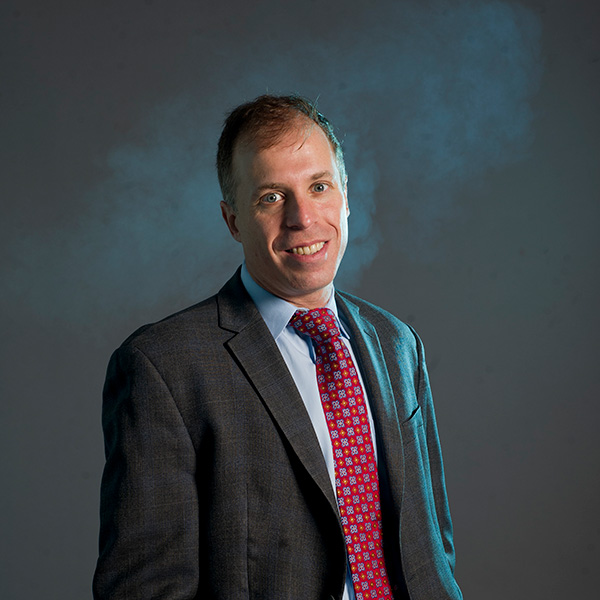With New Technology and Innovative Treatments, BU Cancer Research Is Saving Lives

With New Technology and Innovative Treatments, BU Cancer Research Is Saving Lives
Boston University researchers are leading the fight against cancer with tests that detect the disease earlier, effective medicines that extend patients’ lives, and other breakthroughs that help more people get lifesaving care

Almost 10,000 people in the United States are diagnosed with skin cancer every day; that means one in five Americans will develop skin cancer at some point in their lives.
For some, the news will be bleak. Estimates suggest more than 8,000 people in the US will die of skin cancer this year.

But if it’s detected early, skin cancer is highly treatable and rarely fatal.
If detected early.

In 2024, the FDA cleared a new skin cancer detection device, DermaSensor, powered by Boston University–developed technology.
It uses pulses of light to determine if a spot is an innocent mole—or skin cancer.

In its first year in clinics across the country, DermaSensor was used to scan tens of thousands of lesions and detected 2,000 skin cancers. And it’s finding its way into more and more doctors’ offices.
In October 2024, Time magazine named DermaSensor one of its inventions of the year.
At Boston University, the DermaSensor story—of a cancer-fighting breakthrough making its way from the lab to helping patients in the clinic—is a familiar one. In recent years, BU researchers have pioneered more effective tests for lung and prostate cancers, developed screening guidelines that catch more at-risk patients, and helped invent a chemotherapy drug that takes on advanced breast, lung, and pancreatic cancers.
And all are being used to help prevent and treat cancer right now.
DermaSensor was a breakthrough more than 20 years in the making. In 2001, physicist Irving Bigio came to Boston University and set to work on developing and refining a technique called elastic scattering spectroscopy. It uses beams of light to analyze the structure of tissues. Because different cellular and subcellular structures scatter light differently, the light that bounces back can tell you a lot about the structures—like whether they are malignant or benign.
“When I came to BU, I was able to start collaborating with medical people and research centers here, refining the technology, so it would become clinically more friendly, easy to use with patients,” says Bigio, a BU College of Engineering professor of biomedical engineering and of electrical and computer engineering. The founder of the BU Biomedical Optics Lab, he also holds a position at BU’s Chobanian & Avedisian School of Medicine.
After years of developing the technology, the University and Bigio began looking for partners to put it on the path to clinical use, licensing their patents to DermaSensor.
The company’s device is simple for any primary care physician or nurse to use: they just place it on a mole or lesion and it goes to work. The DermaSensor can help separate mundane moles from more nefarious skin cancers—including the rare, but potentially deadly, melanoma—without the need for an invasive biopsy.
“Our partnership with BU on three different fronts was incredibly important in successfully developing the foundation of the technology that ultimately led to the FDA-cleared DermaSensor device,” says Cody Simmons, DermaSensor cofounder and CEO. In addition to licensing key technology from BU, the company relied on Bigio’s expertise as part of its scientific advisory board and turned to his research team to help test its prototypes. One of Bigio’s former PhD students, Eladio Rodriguez-Diaz (ENG’09), also developed much of the sensor’s machine learning and data analysis technology.
“It is highly gratifying to know that something that came out of my lab is having a positive impact on the welfare of people, and at the earliest possible entry into the healthcare system,” says Bigio.

Catching Lung Cancer Earlier

When physician-scientist Avrum Spira joined the BU medical faculty in 2003, a lot of his clinical time was spent caring for some of the toughest cases in the intensive care unit (ICU)—including patients who were in the end stages of their lives because of lung cancer. Trained as a pulmonologist and an engineer, Spira started wondering whether there might be a way to help catch lung cancer earlier, before it turns deadly.
“Lung cancer kills more people every year in the United States, in the world, than any other cancer, and the reason for that is it’s often diagnosed at a very late stage and hard to catch early,” says Spira, a BU Chobanian & Avedisian School of Medicine professor of medicine, pathology, and bioinformatics. “So, in my research time, I focused on using bioinformatics, then a new discipline, to find ways to diagnose lung cancer earlier.” A mix of science and engineering fields, bioinformatics uses modern data science and statistics tools to study biological data like DNA.
With his BU colleagues, Marc Lenburg and the late Jerome S. Brody, Spira hit upon a potential breakthrough: using a bronchoscopy to collect cells from the upper airway, then studying their genomic profile for potential early signs of lung cancer.
“Lung cancer develops deep in your lungs, but we believed there might be molecular changes in your upper airway that could be a canary in the coal mine,” says Spira, who’s also an attending ICU physician at Boston Medical Center, the University’s primary teaching hospital.
For a decade, he tested that theory in his BU lab, until he and his team found a pattern of gene activity in cells that line the windpipe that could help distinguish someone with lung cancer from someone without. With the University’s help, Spira cofounded a start-up to commercialize a new test to find those patterns in patients. They validated their work in two large clinical trials before being acquired by a larger company, Veracyte, which helped bring the technology to the market.
The test, called Percepta, has been used in clinics for close to a decade, helping thousands of patients. Through an ongoing partnership with Lenburg, a BU professor of medicine, pathology, and bioinformatics, Veracyte is currently working on a new, next-generation version that swaps the bronchoscopy for a simple, noninvasive nasal swab, with the goal of reaching even more people.
“This is a great example of a product that’s helped patients and would never have seen the light of day without the very basic academic, biomedical, foundational research,” says Spira. “To be able to go to the lab and identify a molecular signature that can be used to help diagnose this devastating disease earlier, to make a difference in patients’ lives, is the most gratifying thing I’ve done in my entire academic career.”

Improved Access to Tests and Treatment

While Spira works to improve care, Julie Palmer’s research at BU has helped make sure more cancer patients get a chance to access tests and treatments in the first place.
A cancer epidemiologist, she’s also a cofounder of Boston University’s Black Women’s Health Study, the largest and longest-running study of its kind in the US. In her roles, Palmer has investigated racial disparities and inequities in health. She and her colleagues have researched genetic cancer risk factors, developed breast cancer risk prediction models, and investigated experiences of racism and cancer survival. One of her most recent projects focused on lung cancer screening eligibility—and sparked a change in national guidelines.
Palmer and her team analyzed data from the Black Women’s Health Study and found that shifting the smoking history criteria used to decide who should get a CT scan could help significantly narrow racial inequities in care. According to the American Lung Association, Black people with lung cancer are 15 percent less likely than their white peers to be diagnosed early, and 16 percent less likely to survive five years.
“We found that using a 20 pack-year smoking history cutoff as a selection criterion for lung cancer screening excluded many individuals diagnosed with lung cancer and led to a marked racial disparity in screening eligibility,” says Palmer (SON’80, SPH’85), a professor of medicine at BU’s medical school and director of the University’s Slone Epidemiology Center.
Pack-years is a common method for calculating cumulative smoking history: number of packs per day x number of years of smoking = total pack-years (so a half a pack a day for 30 years equals 15 pack-years). Instead, Palmer’s team discovered that switching to a simple duration cutoff would pull in more patients and be easier for clinicians: if someone has smoked for more than 20 years, they qualify.
“Using a 20-year smoking duration cutoff instead of a 20 pack-year cutoff increased the percentage of Black women with lung cancer who would have qualified for screening from 42.5 percent to 63.8 percent,” Palmer and her colleagues wrote about their results in the Journal of Clinical Oncology; the work was primarily funded by the National Cancer Institute.
The findings prompted the National Comprehensive Cancer Network, an influential alliance of leading cancer centers, to reform its screening guidelines for people aged over 50.
“Cancer is a fact of life. Many of us will get one type of cancer or another during our lifetime,” says Palmer, who is also the Karin Grunebaum Professor in Cancer Research and a BU School of Public Health professor of epidemiology. “I find it personally rewarding to do work that has a real-world impact, not least of which is reducing racial disparities in cancer mortality.”

How Ideas Grow

Once an invention is out in the world, it often takes on a life of its own, spurring other advances or finding new ways to help patients. Take Abraxane, a chemotherapy drug that BU’s Mark Grinstaff, a William Fairfield Warren Distinguished Professor, is credited with helping develop. Approved for taking on breast cancer, it has since been used to fight lung and prostate cancers.
And Ji-Xin Cheng and his team have developed a new type of microscope for more precise diagnosis of prostate cancer. The technology has started being applied to tracking other health issues, while the team’s underlying science has laid the foundation for a new cancer treatment.
Cheng’s microscope, UltraView, was designed to help spot the amount of a form of cholesterol—cholesterol ester—inside a cancer cell. His team had discovered the molecule could help clinicians make a more accurate prostate cancer diagnosis. “Most prostate cancers are benign, but the aggressive ones—when it becomes hormone insensitive—can kill patients, there’s no effective medicines. There’s a need for new markers for diagnosis,” says Cheng, ENG’s Moustakas Chair Professor in Photonics and Optoelectronics. UltraView helps fill that gap and is already available in China, where Cheng says it is being used to diagnose patients and help guide treatment. “It means a lot to me,” he says, “that our discovery can be converted into a product that can save people’s lives.”
Getting the UltraView into clinics marked only the beginning of the story. (The microscope is now being produced by precision healthcare company Vibronix.)
As Cheng’s team delved deeper into the cholesterol ester molecule’s workings, they found that if they blocked the molecule, it helped suppress hormone insensitive prostate cancer. That research led to a new treatment that’s being used in clinics today. “It’s happening in hospitals now, it’s treating patients,” says Cheng, whose research is largely funded by the National Institutes of Health. The team’s work is a “story of discovery, from biomarkers to a molecule-based treatment.”
And as more UltraView systems hit the market, Cheng has begun hearing about other unexpected applications: some researchers, for instance, are using it to track microplastics in tissues, while a team in Vienna, Austria, is exploring its potential in studying how drugs impact the gut microbiome.

Celebrating, but Not Stopping
For all of BU’s cancer researchers, seeing their idea move from the lab into clinics is worthy of celebration—but not a stopping point.
Bigio has studied his sensing technology’s potential in diagnosing colorectal, thyroid, cervical, oral, prostate, and breast cancers. Spira’s work on the lung cancer test led to a new phase in his research: balancing his time at BU with a role as global head of healthcare giant Johnson & Johnson’s Interventional Oncology R&D unit. There, he’s working on not just catching cancers sooner, but also treating them earlier—and in less invasive ways. And Palmer is encouraging clinics to apply a breast cancer risk prediction calculator her team developed and tested.
Across the Boston University community, dozens and dozens of BU and BMC researchers are striving to improve cancer prevention, treatment, and care, pushing forward ideas as diverse as surgical robots, engineered immune cells, and oral cancer therapies. And in time—with the right amount of perseverance, talent, and, crucially, funding support—their breakthroughs will also be saving and extending lives.
To check out other ways BU researchers and research are transforming lives and having an impact on the world, visit You Are Why.
This Series
Also in
Cancer Research at Boston University
-
November 14, 2025
“Science Saved My Life”: Cancer Survivor and BU Alum Joy Huber on Why Research Matters
-
November 14, 2025
Video: Her Grandmother’s Brain Tumor Treatment Inspired This BU Doctor’s Career
-
November 14, 2025
How to Help Someone After a Cancer Diagnosis

